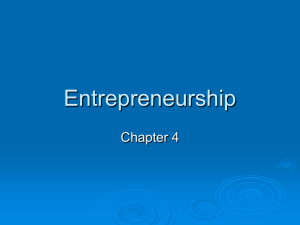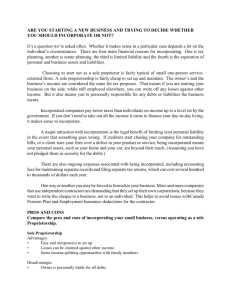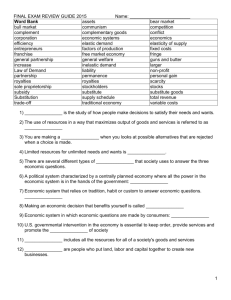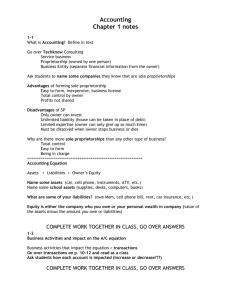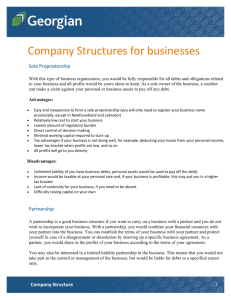Chapter 4 PowerPoint - Wilmot Union High School
advertisement
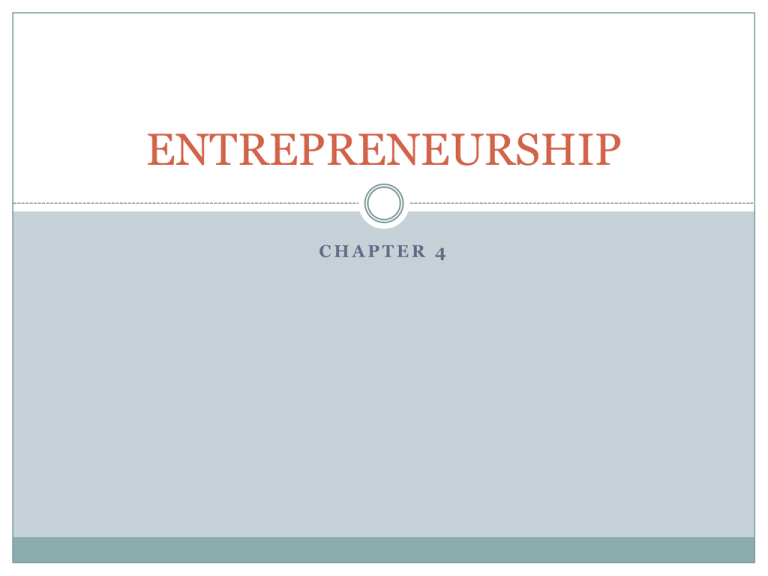
ENTREPRENEURSHIP CHAPTER 4 What is Entrepreneurship? Think of some of your favorite things….clothes, shoes, stores, food, etc? Who started the business? Small businesses, usually those with fewer than 500 employees, represent 99% of American businesses. They employ more than 50% of the nonmilitary workforce. A person who organizes and then runs a business is called an entrepreneur. What is Entrepreneurship? An entrepreneur’s life is challenging Planning is a big part of getting the business up and running Must make good decisions Find inventive solutions to problems Risks are high but the rewards can be great Does this challenge appeal to you? Are you willing to take the risks? Advantages of Entrepreneurship You are in charge Decide when and how hard to work How the business will operate Great job satisfaction Can lead to good income Disadvantages of Entrepreneurship Financial risk Lose initial start up money and more Work long hours Competition can be difficult to overcome No guarantees of success Almost half of new businesses fail within their first four years. Traits of Entrepreneurs Self-motivation They know what they want and believe in their ability to achieve it They stay motivated by setting short and long-term goals. They make a plan how to achieve those goals Perceptive They see opportunities where others do not They look at problems and see opportunities Follow trends Do your research by talking to customers to see how to meet their needs Traits of Entrepreneurs Decisive Make decisions every day Must be good decisions Look at the whole picture How can the decision help How can the decision hurt Being a Business Owner Four main ways to go into business Start a new business 2. Buy an existing business 3. Buy a franchise 4. Join a family business 1. Starting a New Business Chance to work hard and put your business ideas to the test Rewards Do not inherit a pervious owner’s mistakes or poor reputation Develop your own reputation Build the business your way Use your experiences and information you have gained from studying other businesses Personal satisfaction from knowing you built the business Starting a New Business Challenges Requires more time and effort Start-up costs are often high (rent / buy space, equipment, office supplies and insurance) You will have to convince lenders that your business idea is sound It is risky = no guarantees that your business will succeed Buying an Existing Business A successful may be for sale because the owners are retiring or starting a new business An unsuccessful business might be for sale for many reasons Losing money Before buying, see if the problems can be fixed and at what expense Advantages Can put you several steps ahead Save on start-up costs (jump in on leases, purchase existing equipment) Can build on the successes Goodwill or loyalty of existing customers Positive reputation Trained staff Buying an Existing Business Disadvantages Location may be poor Competition may be taking business away Market outlook (potential for future sales) may be poor Building or equipment may need expensive repairs or replacement May have a poor reputation Buying a Franchise Franchise – legal right to sell a company’s goods and services in a particular area Example: restaurants, hair salons, real estate offices, etc. Buy the right to sell another company’s products In addition to paying for the franchise you agree to pay a percentage of your profits to the parent company Buying a Franchise Advantages A recognized product name Established procedures and management systems A business reputation and customer goodwill Training and support services Advertising Financing Disadvantages Pay a portion of the profits to the parent company May be less profitable Must follow the parent company’s guidelines May be less satisfaction because you did not build it Joining a Family Business Advantages Relatives might help you finance the business Family = Loyal + Trust Family members working as a team can achieve more than individuals Relatives can teach you the business Customers are likely to give the same trust and goodwill to a new owner who is part of the previous owner’s family Potential Disadvantages Some families work well together / others do not Difficulties at work can affect family relationships Owning a Business One of the first questions – how to organize your business? Most businesses begin as a sole proprietorship – owned by one person. The owner owns all the assets and debts. A partnership is a legal arrangement in which two or more people share ownership. Control and profits are divided among the partners according a an agreement. All partners are liable for the debts. A corporation is a business chartered by a state that legally operates apart form the owner(s). The owners buy shares of the company. Shareholders have only limited responsibility for the debts. Forms of Legal Ownership Forms of Business Ownership Advantages Disadvantages Sole Proprietorship •Owner makes all decisions •Easiest form of business to set up •Least regulated form •Limited by the skills, abilities, and financial resources of one person •Difficult to raise funds to finance business •Owner has sole financial responsibility for company; personal assets may be at risk Partnership •Can draw on the skills, abilities, and financial resources of more than one person •Easier to raise funds than in sole proprietorship •More complicated than sole proprietorship •Tensions may develop among partners •Owners liable for all business losses; personal property may be at risk Corporation •Easier to finance than other forms of business •Financial liability of shareholders limited •Expensive to set up •Record keeping can be time consuming and costly •Can pay more taxes than other forms Financing Business Plan – gives specific information about your business Describes your product and states where your business will be located How many employees you will hire and what their salaries are Describes your competitors and points out their strengths and weaknesses Describes your marketing plan and timetable Financial Plan – spell out your start-up costs, operating expenses and other costs for the first few months Operating expenses are the cost of doing business (ex. manufacturing and selling the product) Ongoing Operations Must keep accurate financial records Tax purposes Seeking additional financing Tells you how your business is doing Income statement Summary of a business’s income and expenses during a specific period Revenue – income from sales Gross profit – difference between the cost of goods and their selling price Net profit – amount left after operating expenses are subtracted from the gross profit Ongoing Operations Balance Sheet – summarizes a business’s assets, liabilities and owner equity Assets – anything of monetary value that you own (current assets - money in the bank , inventory, etc. / fixed assets – land, equipment, furniture and fixtures) Liabilities = debts a business owes Current liabilities must be paid during the current year Long-term liabilities are not due in the next 12 months Net Worth – difference between assets and liabilities The savings you invest in your business are your equity, or ownership interest, in the business. Ongoing Operations Cash flow statement – a monthly plan that shows when you anticipate cash coming into the business and when you expect to pay out cash This helps you see if you will have enough money to pay your bills Succeeding in Business Location – Are you near your potential customers? Can you work at home to reduce expenses? Online business – location not as important Factors to consider 1. 2. 3. 4. 5. Type of businesses in the area Condition of streets and buildings Cost of property Location of competition Location of your customers Succeeding in Business Competition Know your competitor’s product or service Produce your product better and have better service! Management Successful businesses are usually managed well Poor management is one of the main reasons for business failure Entrepreneurships need skills: reading, writing, listening, speaking, and MATH (setting prices to calculating payroll)
